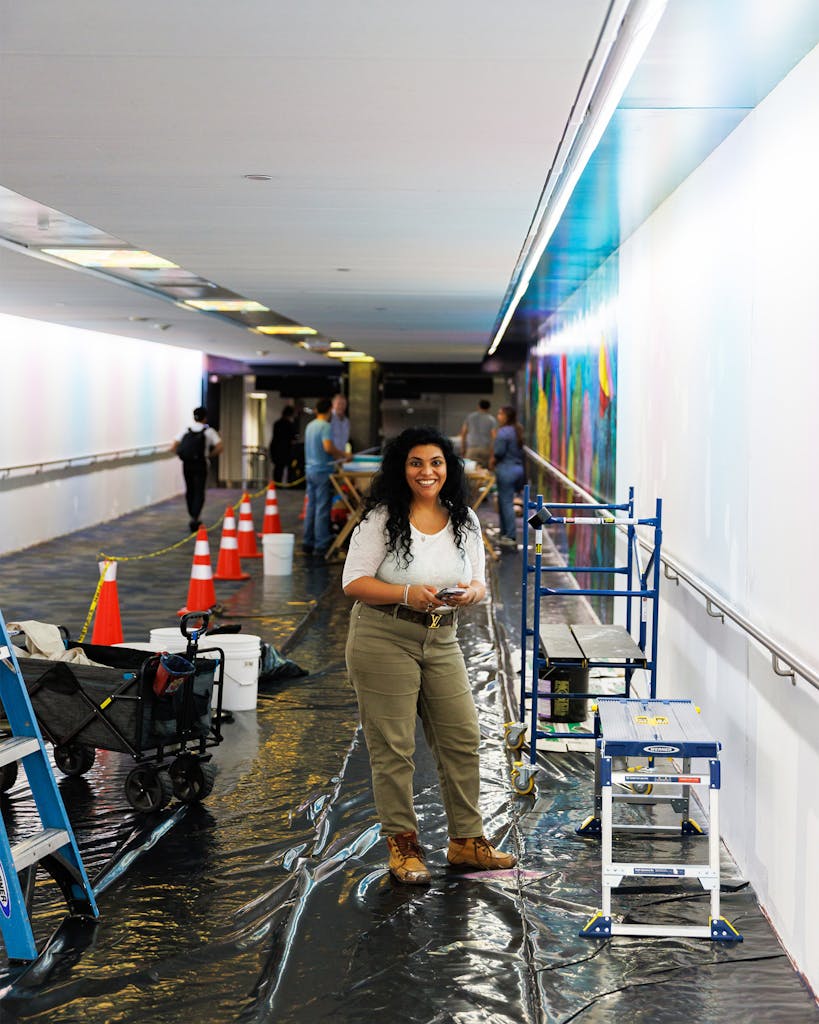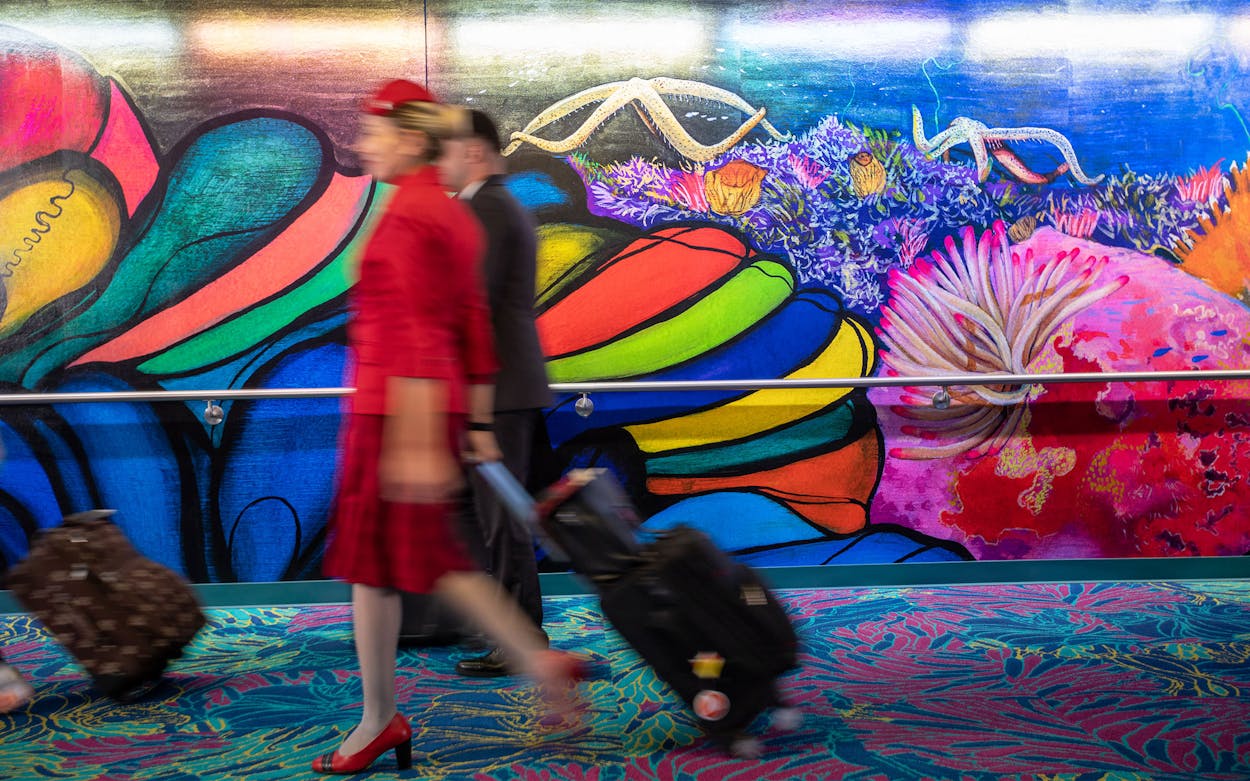“This tunnel is mine,” Janavi Mahimtura Folmsbee kept telling herself.
She wasn’t just sending the thought out to the universe, as she often does when she is trying to will something important to happen. The tunnel she was speaking of—a corridor connecting the two international terminals at Houston’s George Bush Intercontinental Airport—tethers her life, in a way. She traverses it every time she boards a plane to visit her family in Mumbai, India, from her home in Houston. Now she can say it with confidence and pride. Mahimtura Folmsbee, a marine conservation artist and avid scuba diver, has transformed the space from an institutional, gray hallway into an immersive, aquariumlike environment inspired by Flower Garden Banks National Marine Sanctuary.
Mahimtura Folmsbee walked me through the tunnel in late October. She was still recuperating from the final all-nighters it took her and her team to finish the $331,000 project, which was the largest of ten new commissions awarded in 2020 by the Houston Airport System for site-specific art. The system, which has one of the largest public art collections in the aviation industry, also purchased 74 pieces of portable works during the COVID-19 pandemic—all told, a $3 million investment in the Texas art community.
Two hundred and forty feet long, almost 9 feet high, and 22 feet wide, Aquarius aims to remind travelers of the connections between sea, sky, and humanity. It’s named for the constellation Aquarius, the water bearer. Along with “aqua,” for water, Mahimtura Folmsbee also sees “ri,” from the Hindi word humari (meaning “ours”), in the title, as well as the collective pronoun “us.”

Born and raised in a fashionable home overlooking the Indian Ocean, Mahimtura Folmsbee sparkles a bit like a fish herself, favoring gold eyeshadow and blue, pearlescent nail polish. She began scuba diving about thirteen years ago, after graduating from the School of the Art Institute of Chicago. Her mother would have taken her anywhere to dive, she said, but she wanted to relive a childhood trip to beautiful white-sand beaches closer to home, in the tropical archipelago of Lakshadweep. Years earlier, an uncle had discouraged her from diving there—too dangerous, he said. But she and her mother went for it, and they were hooked.
“I fell in love. It was quiet. I was one with my breath, invited to do beautiful things,” Mahimtura Folmsbee said reverently, with a dreamy tone in her voice. Re-creating that feeling for her viewers, to draw attention to the health of the world’s oceans, is what all of her artworks are about.
Aquarius has a huge, captive audience. As many as 3,500 passengers traverse the tunnel between terminals D and E daily, a number that rises during peak travel periods. Stressed and rushing travelers could have a million other things on their minds as they roll their carry-ons through the installation, but Mahimtura Folmsbee has employed every multidisciplinary element the budget would allow to entice them to slow down, breathe, and enjoy the view. Even if they don’t stop, visitors are immersed in a meditative soundscape by Houston composer Andrew Karnavas that reminds me of the serene music at an aquarium. Those who listen carefully may also hear the slight bubbling noise of a diver’s respirator and the subtle crackle of snapping shrimp.


Eye-poppingly colorful murals fill the walls from floor to ceiling, depicting abundant underwater life. A visitor with time on her hands could spend a good while finding and identifying the dozens of creatures Mahimtura Folmsbee selected from the roughly three hundred species of fish, more than twenty species of coral, and other creatures that thrive at Flower Garden Banks. At least four species of sharks—plus dolphins, barracudas, bigeye jacks, manta rays, spotted drum, a moray eel, a hawksbill turtle, squirrelfish, octopi, and lobsters—swim among her branching gorgonians; stony, black, star, brain, ribbon, and mountain corals; bulb tunicates; pink algae clusters; and anemones. Among the oddities are multitudes of Christmas tree worms and the huge slug known as a sea hare.
Mahimtura Folmsbee purposefully made her apex predators beautiful rather than scary-looking, she said, because some of those predators are endangered species, and she wants them to be appreciated rather than feared. As a public artwork, Aquarius had to appeal to a broad audience that would include children. Mahimtura Folmsbee also wanted it to be educational. She consulted with marine scientists in Texas and Louisiana to ensure the work was scientifically accurate. She was also careful to place the various species within their appropriate ocean-depth zones, which range from about 55 to 500 feet.
Her composition seems counterintuitive in one regard: visitors encounter images of creatures from the deepest depths at both ends of the tunnel, while shallower depths are represented in the center. That’s more about creating a balance of colors. “It was a visual and mindful decision to draw the viewer into the artwork,” she said. “It makes a drab, boring tunnel come to life with movement and depth perspective through color.”
Laced throughout are the artist’s own “characters,” as she calls them—a signature motif of undulating, abstract, kelplike forms she employs to make her work feel buoyant. “Children love it,” she said. “It’s very uplifting.” The characters’ vivid blues, reds, greens, and yellows are inspired by the tropical fishes she loves, but they’re also influenced by the vibrant culture of her native country—an aspect that Indian travelers have noticed, she said.
Near the center, visitors can also detect the legs of an offshore oil-and-gas-production platform, a rig built at the southeast corner of the East Flower Garden Bank in 1981. Underwater creatures quickly colonized the structure, which became a popular fishing and diving site within Texas Parks and Wildlife’s Rigs-to-Reefs program after it was decommissioned a decade ago. “I don’t think oil and gas is necessarily a bad thing,” Mahimtura Folmsbee said. “We work together, and a lot of our funding to protect the reef system comes from them.”
The murals began as a series of eight hand-painted miniatures, each of which measures 9 by 240 inches. “You wouldn’t believe how small the brushes were,” the artist said. She had the originals scanned and printed for the monumental installation on nonwoven fabric. Amazingly, most of the images scaled up quite well. Painting directly on the walls would have been too time-consuming, given the airport’s production schedule, although Mahimtura Folmsbee touched up bits around seams and brushed on layers of sparkly pigment made from natural quartz crystals to mimic the flashing colors of the reef’s silver fishes. She added another layer of color by placing filters over the lights bordering the tunnel walls.
When a planned sculptural element proved too costly and too low-hanging for the ceiling, she installed lenticular photographs in the tunnel’s central light panels. Those images change as viewers walk beneath them, revealing the action of spawning coral. At ground level, carpet tiles laid in quarter turns create an abstracted pattern of wavy blue, purple, and green sea anemones. A smartphone filter accessible via a QR code adds an interactive layer of augmented reality: it “submerses” viewers within a video of swimming Mardi Gras wrasse, creating images that can also be captured as selfies.
As we walked the tunnel, occasional announcements from the airport speaker system overrode the tranquil soundtrack. Mahimtura Folmsbee was dismayed by a few dings in the installation that had already appeared, inflicted by careless travelers. Foot traffic came in spurts, some of it heavy. A few people stopped to examine the murals. Two visitors, realizing that Mahimtura Folmsbee was the artist, stopped to talk. “It seems very happy,” one of them told her. “It’s beautiful,” added her companion, who took a selfie with the artist.
No one stopped to read the aqua-colored text panel at the Terminal D entrance while I was there, but it evocatively underscores Mahimtura Folmsbee’s message. Along with the title and the thought “Water is ours and is for all of us,” it presents the word “water” in fifty languages, to represent the diversity of Houston and its travelers.
One of the many airport employees the artist befriended while she was installing the piece stopped by to say hello. She relayed the story of a mesmerized young traveler who said the murals made her feel like a mermaid. “Everybody sees something different in it,” she said.






